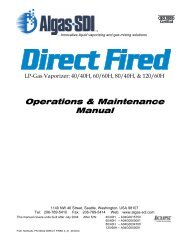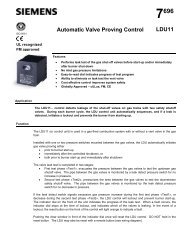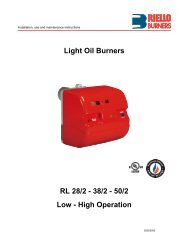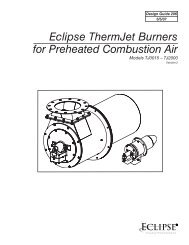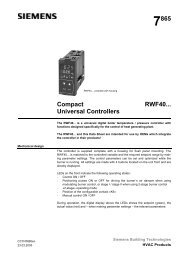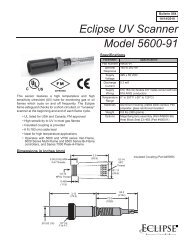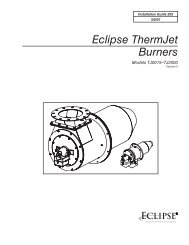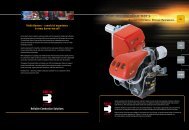Gas Burners RS 70/M - Power Equipment Company
Gas Burners RS 70/M - Power Equipment Company
Gas Burners RS 70/M - Power Equipment Company
Create successful ePaper yourself
Turn your PDF publications into a flip-book with our unique Google optimized e-Paper software.
AIR PRESSURE SWITCH<br />
AIR PRESSURE SWITCH (A)<br />
Adjust the air pressure switch after having performed all<br />
other burner adjustments with the air pressure switch set<br />
to the start of the scale (A).<br />
With the burner operating at min. output, increase adjustment<br />
pressure by slowly turning the relative dial clockwise<br />
until the burner locks out.<br />
Then turn the dial anti-clockwise by about 20% of the set<br />
point and repeat burner starting to ensure it is correct.<br />
If the burner locks out again, turn the dial anti-clockwise<br />
a little bit more.<br />
Attention:<br />
As a rule, the air pressure switch must prevent the formation<br />
of CO.<br />
To check this, insert a combustion analyser into the<br />
chimney, slowly close the fan suction inlet (for example<br />
with cardboard) and check that the burner locks out,<br />
before the CO in the fumes exceeds 400 ppm.<br />
The air pressure switch may operate in "differential"<br />
operation in two pipe system. If a negative pressure in<br />
the combustion chamber during pre-purging prevents<br />
the air pressure switch from switching, switching may be<br />
obtained by fitting a second pipe between the air pressure<br />
switch and the suction inlet of the fan. In such a<br />
manner the air pressure switch operates as differential<br />
pressure switch.<br />
(A)<br />
HIGH GAS PRESSURE SWITCH<br />
D2548<br />
(B)<br />
LOW GAS PRESSURE SWITCH<br />
D2547<br />
HIGH GAS PRESSURE SWITCH (B)<br />
Adjust the high gas pressure switch after having performed<br />
all other burner adjustments with the maximum<br />
gas pressure switch set to the end of the scale (B).<br />
With the burner operating at MAX output, reduce the<br />
adjustment pressure by slowly turning the adjustment<br />
dial anticlockwise until the burner locks out.<br />
Then turn the dial clockwise by 0.8” WC and repeat<br />
burner firing.<br />
If the burner locks out again, turn the dial again clockwise<br />
by 0.4” WC.<br />
(C)<br />
D2547<br />
DA<br />
LOW GAS PRESSURE SWITCH (C)<br />
Adjust the low gas pressure switch after having performed<br />
all the other burner adjustments with the pressure<br />
switch set at the start of the scale (C).<br />
With the burner operating at MAX output, increase adjustment<br />
pressure by slowly turning the relative dial<br />
clockwise until the burner locks out.<br />
Then turn the dial anti-clockwise by 0.8” WC and repeat<br />
burner starting to ensure it is uniform.<br />
If the burner locks out again, turn the dial anti-clockwise<br />
again by 0.4” WC.<br />
FLAME PRESENT CHECK (D)<br />
The burner is fitted with an ionisation (flame rod) system<br />
which ensures that a flame is present. The minimum<br />
current for reliable operation is 6 µA (see manufacturers<br />
documentation). The burner provides a much higher current,<br />
so that controls are not normally required. However,<br />
if it is necessary to measure the ionisation current,<br />
disconnect the plug-socket 6)(A)p.4 on the ionisation<br />
probe cable and insert a direct current microamperometer<br />
with a base scale of 100 µA. Carefully check polarities.<br />
(D)<br />
D795<br />
13




